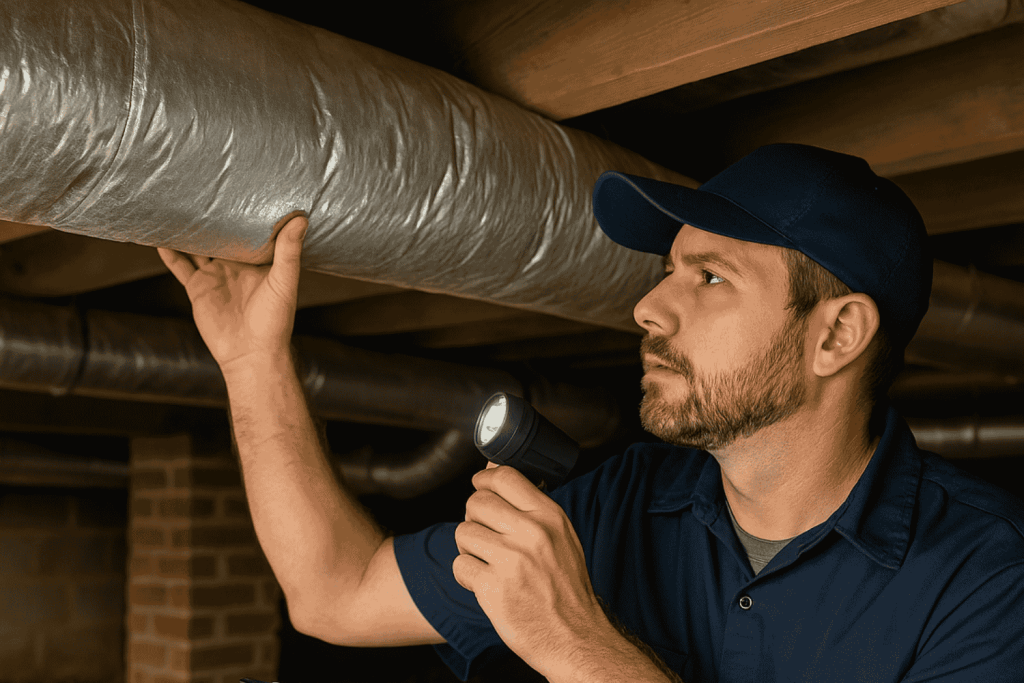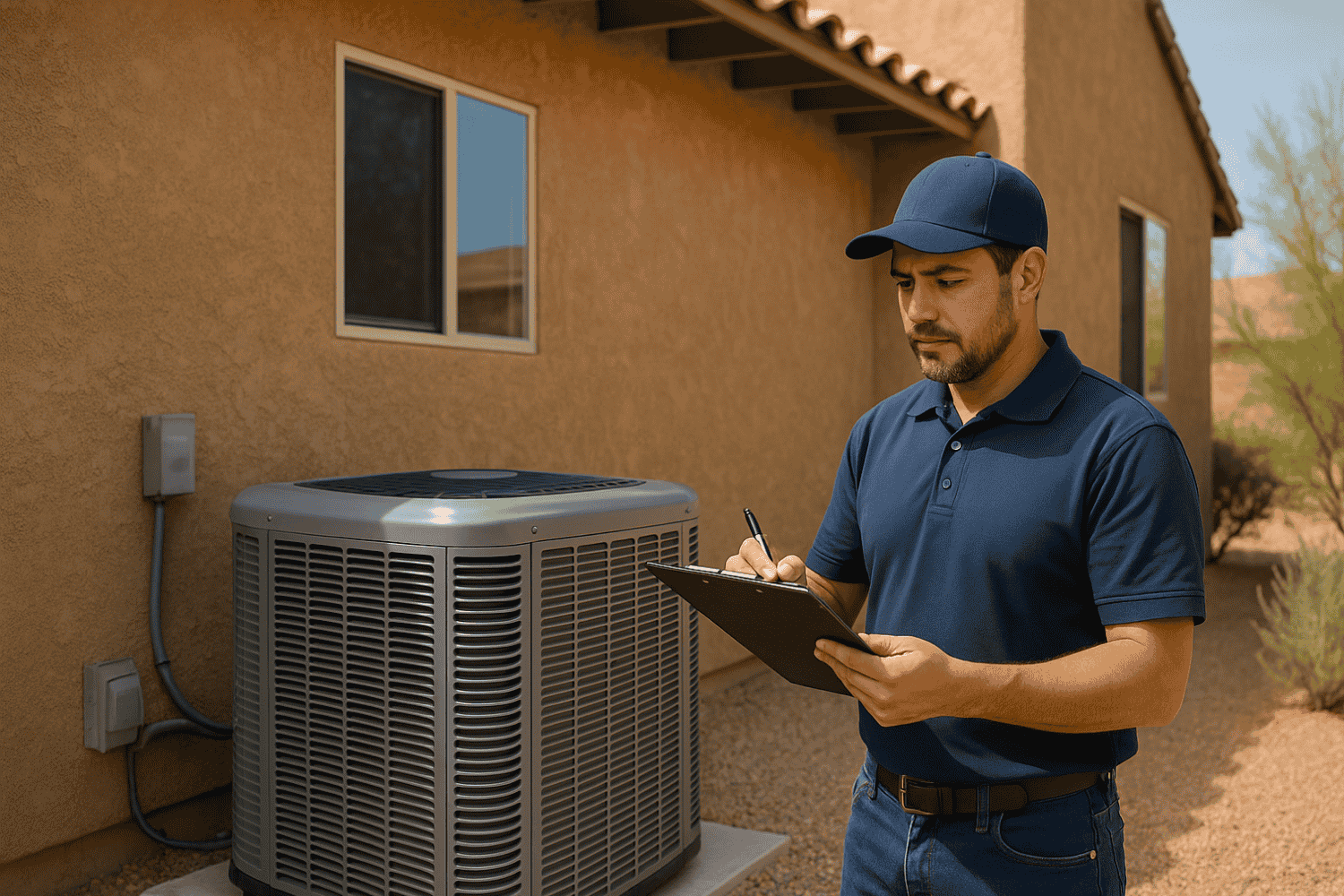In the scorching heat of the Southwest, where HVAC systems often run year-round, it’s no surprise that over 75% of HVAC failures are caused by neglected maintenance.
As a seasoned home inspector in this climate, I’ve seen firsthand how a thorough HVAC inspection checklist can mean the difference between a comfortable summer and a costly emergency repair.
Whether you’re a homeowner trying to stay ahead of issues or a fellow inspector aiming for thoroughness, understanding what goes into an HVAC inspection is essential.
A well-structured checklist not only helps maintain comfort and efficiency but also extends the lifespan of your system and ensures safety in every season. This guide breaks down everything you need to know:
- Why regular HVAC inspections are especially critical in hot, dry regions like the Southwest.
- What a complete HVAC inspection checklist includes, from documentation to system components.
- How using a checklist helps prevent unexpected breakdowns and expensive repairs.
- The essential elements every residential and commercial HVAC checklist should cover.
- Where to find and how to use a printable HVAC inspection checklist template or digital version.
By the end of this article, you’ll walk away with a full understanding of how to use an HVAC inspection checklist, whether it’s for your own home, a client’s property, or a commercial space.
What Is an HVAC Inspection Checklist?
An HVAC inspection checklist is a structured tool used to evaluate the condition, efficiency, and safety of heating, ventilation, and air conditioning systems. It ensures every component is reviewed systematically, reducing the chance of missing critical issues.
As a home inspector in the Southwest, I can’t stress enough how vital it is to use a checklist, especially when temperatures soar and systems are pushed to their limits.
Residential vs. Commercial Checklists
While the core principles are the same, residential and commercial HVAC inspection checklists differ in scope and complexity:
- Residential HVAC inspection checklist: Focuses on comfort systems for single-family homes or small multi-family units. These checklists often include furnace checks, air conditioner performance, air filter conditions, ductwork, and thermostat accuracy.
- Commercial HVAC inspection checklist: Covers larger, more complex systems like rooftop units, chillers, and building automation controls. These require additional checks related to zoning, energy management, and code compliance.
Digital vs. Printable Formats
Depending on your workflow, you can choose between digital and printable formats:
- HVAC inspection checklist apps: Great for field inspectors, allowing real-time data entry, photo upload, and report generation.
- Printable HVAC inspection checklist templates: Ideal for homeowners or inspectors who prefer paper-based records. You can download a free printable HVAC inspection checklist template or a residential HVAC inspection checklist PDF for quick reference.
- HVAC inspection checklist Excel templates: Useful for tracking multiple inspections or properties over time. An Excel printable HVAC inspection checklist template lets you sort, filter, and archive inspection data easily.
Core Components of a Residential HVAC Inspection Checklist
Here’s what I include on every residential HVAC inspection checklist, based on years of fieldwork in the Southwest:
General Information and Documentation
- Customer name and contact information
- Inspection date and property address
- Inspector name and license number
- System type (split, packaged, mini-split, etc.)
- Previous service history and known issues
Heating and Cooling Components
- Burners, flame sensors, and igniters for proper ignition
- Heat exchangers for cracks or corrosion
- Evaporator and condenser coils for dirt buildup
- Blower motors and fan blades for balance and speed control
- Thermostat calibration and setting accuracy
Air Filters and Airflow
- Inspect and replace filters as needed
- Check airflow at registers and grilles
- Adjust dampers or vents for even distribution
Ductwork and Ventilation
- Inspect for disconnected sections, leaks, or crushed ducts
- Ensure duct insulation is intact
- Verify return and supply balance across rooms
Electrical Systems and Controls
- Verify wire connections, fuses, and grounding
- Test thermostat response and control panel function
- Check safety shutoff switches and relays
Refrigerant System
- Measure refrigerant pressure and charge level
- Inspect refrigerant lines for insulation and leaks
- Check flare connections and service valves
Drainage and Condensate Management
- Flush condensate lines and inspect pans for rust or debris
- Check condensate pumps for proper operation
Motors, Belts, and Lubrication
- Inspect belt tension and alignment
- Lubricate motors and bearings where applicable
- Test motor amperage and operation
Air Quality Equipment
- Inspect and clean humidifiers, dehumidifiers, and air purifiers
- Test indoor air quality (IAQ) sensors

When and How Often To Inspect Your HVAC System
In my experience, the best time to inspect your HVAC system is just before peak seasons (spring and fall). This ensures your system is ready for summer cooling or winter heating.
Creating a Maintenance Schedule
Set reminders to inspect twice a year. Use a home maintenance calendar or app to track inspections and filter changes. Homeowners can even integrate this into seasonal chores like roof checks or gutter cleaning.
Updating the Checklist
As systems age or are upgraded, update your HVAC inspection checklist template to reflect new components or changes in code. For example, if you add a whole-home air purifier or switch to a heat pump, your checklist should evolve accordingly.
Tools and Templates for Inspectors and Homeowners
Printable HVAC Inspection Checklist Templates
Download a free printable HVAC inspection checklist template for basic residential inspections. You can find a HVAC system inspection checklist in PDF format that works well for homeowners wanting a physical record.
HVAC Inspection Checklist in Excel
An HVAC inspection checklist Excel template is perfect for managing multiple properties or scheduled inspections. You can log each visit, track system performance over time, and even generate maintenance reports.
HVAC Inspection Checklist Apps
For professionals, using a HVAC inspection checklist app speeds up fieldwork, offers real-time reporting, and allows you to send digital reports to clients immediately.
Common Issues Identified During Inspections
Safety Hazards
- Carbon monoxide leaks from cracked heat exchangers
- Frayed or exposed wiring that could spark a fire
- Blocked exhaust vents or gas leaks
Efficiency Problems
- Dirty or clogged filters limiting airflow
- Low refrigerant levels causing poor cooling
- Obstructed or leaky ducts reducing system output
Signs of Wear and Aging
- Rust on coils or pans
- Noisy motors or loose belts
- Frequent cycling or slow system response
Stay Ahead of the Game With a Reliable HVAC Inspection Checklist
In the demanding climate of the Southwest, proactive HVAC maintenance isn’t just smart; it’s essential. As we’ve explored throughout this guide, a thorough HVAC inspection checklist empowers homeowners and inspectors alike to ensure system safety, efficiency, and longevity.
From checking air filters and ductwork to inspecting refrigerant lines and electrical controls, each component plays a critical role in keeping your indoor environment comfortable and your energy bills manageable.
Whether you’re performing a seasonal check or preparing a property for sale, having a structured approach ensures nothing is overlooked. With today’s tools, such as printable templates, Excel trackers, and mobile apps, you can tailor your inspection process to fit your workflow perfectly.
Don’t wait for a system failure to take action. Equip yourself with the right resources to inspect with confidence and clarity. Start by downloading a free printable HVAC inspection checklist template and take the first step toward smarter HVAC maintenance today.



